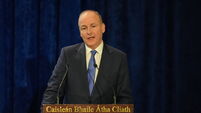SF jobs plan is well worked out and deserves to be taken seriously
Taken over the period, the projections for jobs are probably overly optimistic. However, the predictions for jobs in 2011 based on the investment of €2bn are pretty accurate. Overall, the plan could significantly reduce unemployment in the short term.
The plan makes use of the government spending multipliers as published by the ESRI. The plan envisages the creation of 160,000 jobs directly as a result of the €7.6bn stimulus. This estimate may still be optimistic, but it is likely a stimulus package of this magnitude would create 100,000 jobs.
The plan proposes to invest €2bn in job creation this year with the remainder to be spent from between January 2012 and July 2014. The €2bn would be spent this year on the agri-food sector; health infrastructure; school buildings and refurbishment; creches; investment capital for new businesses, and the creation of new jobs in frontline services where existing staff are over-worked.
The plan projects the creation of 5,000 direct jobs and 2,000 indirectly in the agri-food sector based on an investment of €500m by the state. This return of jobs for investment is accurate and in keeping with the ESRI multipliers. The investment in the health sector is identical, as is the number of jobs predicted. Again, this is credible. Similarly, the plan envisages a return of 4,000 direct and 1,600 indirect jobs in the health sector and 6,200 jobs overall arising from the investment of €435 million in a National Broadband Infrastructure. These figures are quite realistic.
On a less positive note, the amount being proposed to provide assistance to people starting a business at €2m is probably too little. This looks like it is being done on the cheap through the use of a “virtual helpdesk for business start-ups with legal, HR, patents, accountancy and other advice”. The creation of an ‘innovation website’ displays the same weakness. People starting up a business surely need in-depth, face-to-face advice.
It could also be argued the plan doesn’t say what organs within the state enterprise apparatus will be delivering the money. It doesn’t say whether the €2bn will be spent by Enterprise Ireland or IDA Ireland or Enterprise Boards.
Despite the fact Sinn Féin mentions that its bigger document, entitled Getting Ireland Back to Work, of March ’09, contains more detail on the proposals, this doesn’t excuse the fact there is no discussion of how the €5.5bn of stimulus within the plan between 2012 and 2014 will be spent.
The plan for 2011 is well worked out. However one suspects the level of job creation for the remaining years of the plan may be overly optimistic.
Nonetheless, the creation of somewhere between 100,000 and 160,000 jobs in three-and-a-half would be a huge result.
The fact the party would spend €7.5bn on economic stimulation to create jobs highlights the high priority it places on reducing unemployment and offering jobs to those who would emigrate.
This plan deserves to be taken seriously by anybody who wants an economic future for their family and the service improvements which this would bring.
* Tom O’Connor is a lecturer in economics at CIT.












